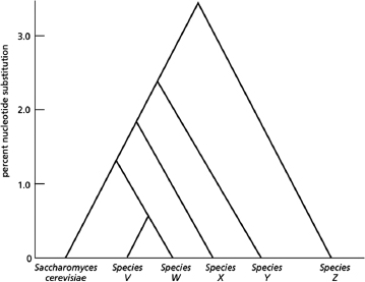Multiple Choice
You are interested in finding out how the budding yeast Saccharomyces cerevisiae is so good for making bread and have collected five new related species from the wild.You sequence the genomes of all of these new species and also consult with a fungal biologist to help you construct the phylogenetic tree shown in Figure 9-19.You find that species V, W, and X make pretty good bread whereas species Y and Z do not, suggesting that the last common ancestor of species X and S.cerevisiae may have the genes necessary for making good bread.You compare the gene sequences of species X and S.cerevisiae and find many identical coding sequences, but you also identify nucleotides that differ between the two species.Which species would be the best to examine to determine what the sequence was in the last common ancestor of species X and S.cerevisiae?  Figure 9-19
Figure 9-19
A) species V
B) species W
C) species Y
D) species Z
Correct Answer:

Verified
Correct Answer:
Verified
Q12: Which of the following generalities about genomes
Q13: The nucleotide sequences between individuals differ by
Q14: Which of the following functions do you
Q15: You isolate a pathogenic strain of E.coli
Q16: Which of the following statements about the
Q18: Which of the following processes is NOT
Q19: Which of the following statements is FALSE?<br>A)The
Q20: HIV is a human retrovirus that integrates
Q21: For each of the following sentences,
Q22: Which of the following statements about mobile